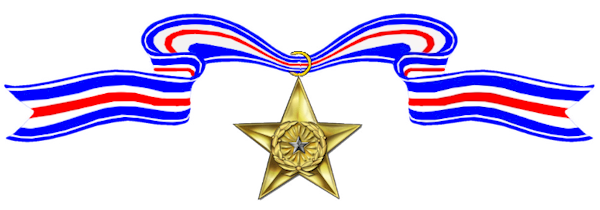Frederick Gunn graduated from the U.S. Naval Academy at Annapolis, Class of 1934. He retired as a U.S. Navy Rear Admiral.

–
Awards Received
-

Silver Star
-

Navy Cross
-

Silver Star
-
Silver Star
Service:
United States NavyRank:
LieutenantDivision:
U.S.S. Trout (SS-202)Action Date:
January 12 – March 3, 1942
Headquarters, Hawaiian Department, U.S. Army, General Orders No. 39 (1942) & Bureau of Naval Personnel Information Bulletin No. 302 (May 1942)The President of the United States of America, authorized by Act of Congress, July 9, 1918, takes pleasure in presenting the Silver Star (Army Award) to Lieutenant Frederick Arthur Gunn, United States Navy, for gallantry in action and participation in the accomplishment of an unusual and hazardous mission for the War Department in enemy-controlled waters during January – March 1942, while a member of the crew of the U.S.S. TROUT (SS-202). Carrying a heavy load of anti-aircraft ammunition urgently needed by the beleaguered forces of General Douglas MacArthur in the Philippine Islands, the U.S.S. TROUT departed from Pearl Harbor, Territory of Hawaii, for Corregidor Island, Manila Bay, at 0900 on 12 January 1942, refueling at Midway Island on 16 January 1942. The U.S.S. TROUT proceeded on the surface until 21 January, traveling submerged thereafter during daylight hours. At 0230 on 27 January 1942, an unsuccessful night attack was made on a lighted vessel, resulting in the U.S.S. TROUT being chased by the vessel at such speed as to for the TROUT to dive in order to escape. On 3 February 1942, after dark, the TROUT made rendezvous off Corregidor with an escort motor torpedo boat. The TROUT then followed the escort at high speed through a winding passage in a mine field to South Dock, Corregidor Island, where she unloaded 3500 rounds of anti-aircraft artillery ammunition for the Army Forces defending Bataan Peninsula and Corregidor. Twenty tons of gold and silver, securities, diplomatic and United States mail and two additional torpedoes were loaded on the TROUT for the return voyage. The TROUT cleared the Corregidor dock at 0300, 4 February and bottomed in Manila Bay during daylight on 4 February. Surfacing that night, additional securities and mail were loaded before the TROUT departed from Manila Bay through the mine field. On the return trip one enemy merchant vessel and one patrol vessel were attacked and sunk. The U.S.S. TROUT arrived at Pearl Harbor on 3 March 1942, after 51 days at sea.
-
Navy Cross
Service:
United States NavyRank:
CommanderDivision:
U.S.S. Scabbardfish (SS-397)Action Date:
November 2 – December 20, 1944
Commander In Chief Pacific: Serial 01846 (March 3, 1945)The President of the United States of America takes pleasure in presenting the Navy Cross to Commander Frederick Arthur Gunn, United States Navy, for extraordinary heroism in the line of his profession as Commanding Officer of the U.S.S. SCABBARDFISH (SS-397), on the SECOND War Patrol of that submarine during the period 2 November 1944 to 20 December 1944, in enemy controlled waters of the Nanpo Shoto Area. Despite adverse weather conditions, Commander Gunn launched six well-planned and brilliantly executed torpedo attacks which resulted in the sinking of enemy shipping totaling over 8,000 tons, including a submarine from which a survivor was captured, and the damaging of an additional 3,000-ton vessel. By his sound tactical judgment and outstanding fortitude, Commander Gunn enabled his ship to perform valuable lifeguard duties during air strikes on Japan, and his expert seamanship throughout was in keeping with the highest traditions of the United States Naval Service.
-
Silver Star
Service:
United States NavyRank:
Commander [then Lieutenant]Division:
U.S.S. Trout (SS-202)Action Date:
1942/1943
Commander, Submarine Forces Pacific Fleet: Serial 02318 (September 16, 1945)The President of the United States of America takes pleasure in presenting a Gold Star in lieu of a Second Award of the Silver Star to Commander [then Lieutenant] Frederick Arthur Gunn, United States Navy, for conspicuous gallantry and intrepidity as Diving Officer of the Submarine U.S.S. TROUT (SS-202), during a War Patrol of that vessel in action against enemy Japanese forces in the Pacific War Area. Exercising careful and precise depth control, Commander Gunn rendered invaluable assistance to his Commanding Officer in conducting aggressive and successful attacks which resulted in the sinking of five enemy ships and the damaging of another for a total of approximately 46,000 tons of hostile shipping. By his judgment, courage and devotion to duty, he contributed materially to the successful evasion of severe enemy countermeasures, and his conduct throughout was in keeping with the highest traditions of the United States Naval Service.

